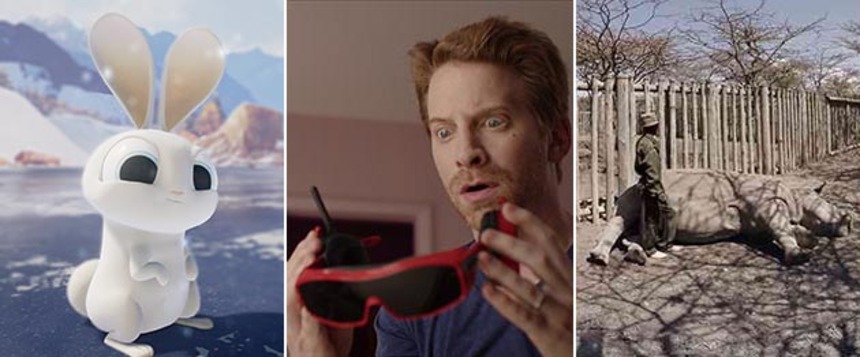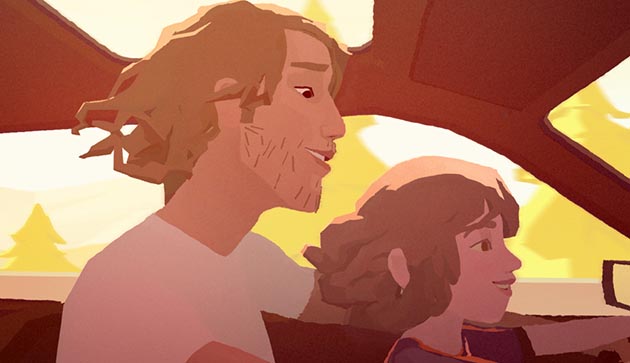Tribeca 2016: VR Round-Up

Pretty much every film festival these days has a Virtual Reality component and it's always interesting to see how festivals handle the emerging platform differently. Sundance's New Frontier is on the forefront of VR exhibition but even that stalwart has its struggles with long lines and loud rooms (see my Sundance 2016 New Frontier VR Round-Up for more). At Tribeca 2016 it was an evolving program of 'experiences' that saw the installations on offer switching up as the festival progressed. That made it difficult to do it all unless you could devote multiple days, but also allowed more artists to exhibit their pieces in relatively quieter spaces.
While we all stumble around in the dark trying to figure out how to properly share VR with the masses at film festivals, there's no doubt it's an exciting time to be experimenting with the medium. A new batch of VR narratives made their debut at Tribeca. I'll delve into a few in a moment but it's worth noting that Tribeca was also packed with other interactive and VR based experiences that were more on the game side than narrative or were interactive in ways unrelated to VR. There is a lot happening in this space and Tribeca is a fantastic place to see much of it in action.
 On the purely narrative front, the most exciting piece was probably Invasion! which is directed by Madagascar and Antz director Eric Darnell and produced by exciting VR production house Baobab Studios. While it's pretty short, it undoubtedly takes advantage of VR's presence potential by transporting you to a beautifully rendered cartoonish world and sticking you in the body of a cute bunny. Your Bunny pal and you watch as a group of silly aliens attempt to make you the first on their list of victims as they take over the Earth.
On the purely narrative front, the most exciting piece was probably Invasion! which is directed by Madagascar and Antz director Eric Darnell and produced by exciting VR production house Baobab Studios. While it's pretty short, it undoubtedly takes advantage of VR's presence potential by transporting you to a beautifully rendered cartoonish world and sticking you in the body of a cute bunny. Your Bunny pal and you watch as a group of silly aliens attempt to make you the first on their list of victims as they take over the Earth.
It's a silly little story and hardly a fully developed narrative but the cartoonish realism of the world is remarkable. When the bunny hides behind you, he (or she) peeks out from around your shoulder, simultaneously directing your attention to what's happening and giving you a sense of empathy for the rabbit whose body you're inhabiting. You actually feel like you're protecting the other bunny. This adds to the experiential realism and the sense you're in the cartoon. Imagining this as a longer and fully developed narrative reminds us that this is just a taste of the amazing things we'll see from Baobab in the near future.
 Also animated and rather narrative - though a bit more in the way some music videos are narrative, Pearl from Google Spotlight Stories is a touching and beautifully rendered experience. Directed by Oscar-nominated Patrick Osbourne, Pearl is a music-infused story of a car and its owner as he watches his daughter grow from just a wee tot helping him busk across the country into a rock and roll star. You could call it a coming-of-age story and it really succeeds at pulling at your heart strings. The VR element is interesting and focuses on the immersive factor to help tell the story more than the actual presence of being in the car. But it's another step forward in defining the grammar of VR narrative.
Also animated and rather narrative - though a bit more in the way some music videos are narrative, Pearl from Google Spotlight Stories is a touching and beautifully rendered experience. Directed by Oscar-nominated Patrick Osbourne, Pearl is a music-infused story of a car and its owner as he watches his daughter grow from just a wee tot helping him busk across the country into a rock and roll star. You could call it a coming-of-age story and it really succeeds at pulling at your heart strings. The VR element is interesting and focuses on the immersive factor to help tell the story more than the actual presence of being in the car. But it's another step forward in defining the grammar of VR narrative.
 On the live action side of things, Lilian Mehrel's Haunt plays with presence and stitching in an interesting way placing you in the 'body' of a ghost. We hear the character speak through voiceover to drive the narrative forward as other characters kind of just go about their day to day activities. The camera is static as we jump from environment to environment which can feel a bit abrupt. However, stitching artifacts are used to interesting effect by creating a 'glitch in the Matrix' feel to reality.
On the live action side of things, Lilian Mehrel's Haunt plays with presence and stitching in an interesting way placing you in the 'body' of a ghost. We hear the character speak through voiceover to drive the narrative forward as other characters kind of just go about their day to day activities. The camera is static as we jump from environment to environment which can feel a bit abrupt. However, stitching artifacts are used to interesting effect by creating a 'glitch in the Matrix' feel to reality.
Sharknado director Anthony C. Ferrante has a VR short called Killer Deal that stars Ian Ziering and plays with some genre tropes we've come to know in flat video. It has a similar quality of FX work to those films but does give us the largest amount of fake blood we've seen to date in VR.
As I mentioned in my Holidays review, the segment Christmas by Scott Stewart is available watch in VR as well. Most of the short is just traditional flat video on a screen but when the characters slip on the UVU VR goggles we are transported to a 360 world. It's an interesting and valuable exploration of the transition between the two mediums.
When it comes to non-scripted informational experiences (i.e. documentary), there were a couple cool pieces on display that focused on Africa. The first, called Kanju by Azimyth Studios is a series of 4 short docu pieces that essentially just set a 360 camera in an interesting place in Africa. These four places are a floating slum, a Nigerian film set, a Barack Obama rally in Kenya, and a park where a man dances in Rwanda. Of these, the floating slum makes the best use of the immersive factor as the camera is actually on a boat as it navigates the waterways. The most exciting moment comes when you get a glimpse of a huge bridge towering in the background. This speaks to VR's potential to show scale in new ways and should be taken of note by filmmakers as how to make something interesting. By contrast, a man dancing in a park is boring once we've experienced it for a few seconds.
 Not at all boring was the extremely impressive piece titled The Ark by Kel O'Neill and Eline Jongsma. This docu project focuses on the quickly disappearing population of white rhinos (down to four) and the people fighting to save them (or perhaps reinvent them) in San Diego and Africa. O'Neill and Jongsma, the recipients of the Tim Hetherington grant, employ a ton of interesting aspects including a sci-fi-ish soundtrack and a totally innovative screen-splitting technique to bend reality in new ways. Expect more interesting things from these two in the future as we continue to experiment in the grammar of storytelling in virtual reality.
Not at all boring was the extremely impressive piece titled The Ark by Kel O'Neill and Eline Jongsma. This docu project focuses on the quickly disappearing population of white rhinos (down to four) and the people fighting to save them (or perhaps reinvent them) in San Diego and Africa. O'Neill and Jongsma, the recipients of the Tim Hetherington grant, employ a ton of interesting aspects including a sci-fi-ish soundtrack and a totally innovative screen-splitting technique to bend reality in new ways. Expect more interesting things from these two in the future as we continue to experiment in the grammar of storytelling in virtual reality.






